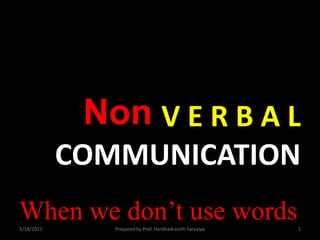Non verbal communication for slideshare
- 1. NonV E R B A LCOMMUNICATIONWhen we donât use words3/18/2011Prepared by Prof. Harbhadrasinh Sarvaiya1
- 2. when we donât use WORDS3/18/2011Prepared by Prof. Harbhadrasinh Sarvaiya2
- 3. Nonverbal communication is usually understood as the process of communication through sending and receiving wordlessmessages.3/18/2011Prepared by Prof. Harbhadrasinh Sarvaiya3
- 4. WORDLESS3/18/2011Prepared by Prof. Harbhadrasinh Sarvaiya4
- 5. Non-verbal communication includes facial expressions, eye contact, tone of voice, posture & motions, and positioning within groups. 3/18/2011Prepared by Prof. Harbhadrasinh Sarvaiya5
- 6. It may also include the way we wear our clothes or the silence we keep.3/18/2011Prepared by Prof. Harbhadrasinh Sarvaiya6
- 7. There are more than700,000forms of nonverbal communication3/18/2011Prepared by Prof. Harbhadrasinh Sarvaiya7
- 8. PUSHPAK3/18/2011Prepared by Prof. Harbhadrasinh Sarvaiya8
- 9. We Communicate less with words !3/18/2011Prepared by Prof. Harbhadrasinh Sarvaiya9
- 10. Characteristicsof NonverbalCommunication3/18/2011Prepared by Prof. Harbhadrasinh Sarvaiya10
- 11. Primarily communicates emotions and attitudesâThe sales meeting is coming up next Monday.â3/18/2011Prepared by Prof. Harbhadrasinh Sarvaiya11
- 12. Ambiguous(no dictionary can actually classify them) Substitutes, contradicts, emphasizes or regulates verbal message(a good orator utilizes this)3/18/2011Prepared by Prof. Harbhadrasinh Sarvaiya12
- 13. 3/18/2011Prepared by Prof. Harbhadrasinh Sarvaiya13
- 14. Continuous(itâs possible to stop talking, not communicating)Reliable(difficult to fake)Culture Bound(thumbs up)3/18/2011Prepared by Prof. Harbhadrasinh Sarvaiya14
- 15. Types of NonverbalCommunication3/18/2011Prepared by Prof. Harbhadrasinh Sarvaiya15
- 16. ParalanguageKinesicsProxemics3/18/2011Prepared by Prof. Harbhadrasinh Sarvaiya16
- 17. How you say what you sayParalanguageI NEVER TOLD YOU.3/18/2011Prepared by Prof. Harbhadrasinh Sarvaiya17
- 18. I never told you.i NEVER told you.i never TOLD you.I never told YOU.3/18/2011Prepared by Prof. Harbhadrasinh Sarvaiya18
- 19. Rate-speed150 words/minuteVolumeSituationalRhythmPeriodicity of stressPronunciationenunciationSegregatesEr⊠UmmmmâŠ.3/18/2011Prepared by Prof. Harbhadrasinh Sarvaiya19
- 20. 39%meaning is affected by vocal cues-not the words butthe way they are said3/18/2011Prepared by Prof. Harbhadrasinh Sarvaiya20
- 21. KINESICSBody Language3/18/2011Prepared by Prof. Harbhadrasinh Sarvaiya21
- 22. 3/18/2011Prepared by Prof. Harbhadrasinh Sarvaiya22
- 23. The gestures, postures, and facial expressions by which a person manifests various physical, mental, or emotional states and communicates nonverballywith othersThe American HeritageÂź Dictionary of the English Language3/18/2011Prepared by Prof. Harbhadrasinh Sarvaiya23
- 24. Gestures and PosturesMovement of Body can express both general and specific messagesVOLUNTARYINVOLUNTARY3/18/2011Prepared by Prof. Harbhadrasinh Sarvaiya24
- 25. 3/18/2011Prepared by Prof. Harbhadrasinh Sarvaiya25
- 26. FINGERSThe âO.K.â signal. (the thumb and forefingerform a circle) means âfine,â or âO.K.â in mostCultures..âzeroâ or âworthlessâ in some parts of Europe..âmoneyâ in Japan..An insult in Greece, Brazil, Italy, Turkey, Russiaand some other countries..3/18/2011Prepared by Prof. Harbhadrasinh Sarvaiya26
- 27. FINGERS (Contâd)Pointing with the index finger iscommon in North America andEurope..But it is considered impolite inJapan and China where theyfavor using the whole open hand..3/18/2011Prepared by Prof. Harbhadrasinh Sarvaiya27
- 28. Gestures & PosturesStanding position
- 29. Walking style
- 30. Hand Movements3/18/2011Prepared by Prof. Harbhadrasinh Sarvaiya28
- 31. Facial Expressions3/18/2011Prepared by Prof. Harbhadrasinh Sarvaiya29
- 32. Facial Expressions3/18/2011Prepared by Prof. Harbhadrasinh Sarvaiya30
- 33. Facial ExpressionsFace is the index of Mind
- 34. The eyes, the lips and the muscles express many feelings
- 35. It can also be deceived by manipulation3/18/2011Prepared by Prof. Harbhadrasinh Sarvaiya31
- 36. 3/18/2011Prepared by Prof. Harbhadrasinh Sarvaiya32
- 37. 3/18/2011Prepared by Prof. Harbhadrasinh Sarvaiya33
- 38. 3/18/2011Prepared by Prof. Harbhadrasinh Sarvaiya34
- 39. 3/18/2011Prepared by Prof. Harbhadrasinh Sarvaiya35
- 40. Eye contact is most effective in the goal to gain someoneâs trust3/18/2011Prepared by Prof. Harbhadrasinh Sarvaiya36
- 41. Stare or fixed gazesuggest involvement orwonder or disapproval----------------Raised looksshow dominance3/18/2011Prepared by Prof. Harbhadrasinh Sarvaiya37
- 42. Downcast looks suggest weakness and submission
- 43. Direct eye contact communicates honesty, transparency and neutral attitude3/18/2011Prepared by Prof. Harbhadrasinh Sarvaiya38
- 44. SPACE3/18/2011Prepared by Prof. Harbhadrasinh Sarvaiya39
- 45. SpaceIDistance as an indicator of intimacySpaceIDistanceasindicator of status Space and Distance3/18/2011Prepared by Prof. Harbhadrasinh Sarvaiya40
- 46. DistanceIntimate distance-no more than 18 inches apart mom and babyPersonal Distance-18 inches to 4 feet - Casual and personal conversations3/18/2011Prepared by Prof. Harbhadrasinh Sarvaiya41
- 47. DistanceSocial distance-4-12 feet impersonal, business, social gatherings Public distance-More than 12 feet Public speaking3/18/2011Prepared by Prof. Harbhadrasinh Sarvaiya42
- 48. Letâs take a guess3/18/2011Prepared by Prof. Harbhadrasinh Sarvaiya43
- 49. So What Does This Mean?Let me see!AuthoritativePondering ThinkingConsidering3/18/2011Prepared by Prof. Harbhadrasinh Sarvaiya44
- 50. So What Does This Mean?Can I help!Trust me!Youâre in good hands!Helping Hand3/18/2011Prepared by Prof. Harbhadrasinh Sarvaiya45
- 51. So What Does This Mean?DejectedDisappointedLost it.3/18/2011Prepared by Prof. Harbhadrasinh Sarvaiya46
- 52. So What Does This Mean?So tell me more!OpenAcceptingWelcoming3/18/2011Prepared by Prof. Harbhadrasinh Sarvaiya47
- 53. 3/18/2011Prepared by Prof. Harbhadrasinh Sarvaiya48
- 54. 3/18/2011Prepared by Prof. Harbhadrasinh Sarvaiya49
- 55. Silence3/18/2011Prepared by Prof. Harbhadrasinh Sarvaiya50
- 56. 3/18/2011Prepared by Prof. Harbhadrasinh Sarvaiya51
- 57. A BIG THANK YOUharbhadrasinh@gmail.comhttp://harbhadrasinh.blogspot.com/3/18/2011Prepared by Prof. Harbhadrasinh Sarvaiya52




















































